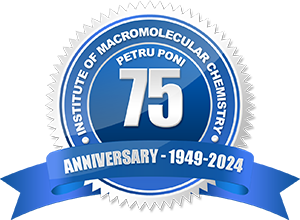While the primary scientific interest of the group was mainly focused on the synthesis and characterization of new polysulfones and thermotropic liquid crystals based on azomethine linkage, the scientific expertise of the group continuously evolved in line with the new requirements of the contemporary world. Important results are:
I. Eco-materials based on chitosan. This research direction meets the new eco-design requirements of the contemporary world, in accordance with the new directives of the European Commission, which aims to protect non-renewable resources and prevent pollution. In this respect, the group develops chitosan-based organic materials, a linear polysaccharide derived from abundant renewable resources (eg crustaceans, insects, fungi and seaweed), which has superior bioactive properties, being safe for consumers and low cost.
- I.1. Chitosan based hydrogels with controlled properties under the synthetic conditions. Biocompatible hydrogels are synthesized, suitable for in vivo applications (controlled drug release systems, scaffolds for tissue regeneration): with antifungal activity, luminescent hydrogels as metal chemosensors, superabsorbent hydrogels for application as soil conditioners and hygiene products, chiral hydrogels for enantiomeric separation.
- I.2. Nanoporous imino-chitosan fibers. The fibers are obtained by electrospinning and are further functionalized with different bioactive agents, function on the targeted application: antifungal materials for wound healing, especially for the treatment of burns, controlled drug delivery systems, luminescent chemosensors, capture and sequestration of CO2 in the atmosphere.
- I.3. Imino-chitosan films. Obtaining imino-chitosan films with high conversion degree of the amine groups of chitosan in imine units. Due to the reversible character of the imine units, the films have dynamic properties, which are activated in a humid environment.
II. Phenothiazine based materials for opto-electronic applications. This research direction is dedicated to the obtaining of materials with efficient light emission in solid state, for organic light emission diodes (OLEDs). It consists in design and synthesis of new compounds and their materials preparation.
- II.1. Synthesis of low molecular weight compounds with aggregation induced emission (AIE), based on phenothiazine and heavy halogen atoms, with a RIR (restricted intramolecular rotation) design.
- II.2. Grow of single crystals. Experience in growing single crystals, important aspect in understanding the structure/properties relationship, for the development of materials with increased efficiency.
- II.3. Preparation of nanocrystals. Preparation of nanocrystals by the reprecipitation method, solvent induced phase separation, temperature induced phase separation, emulsion phase separation. The materials obtained are appropriate for application as OLEDs or bio-applications.
- II.4. Grow of cocrystals based on the synthetized compounds. In order to enhance the luminescent properties, the synthetized compounds are grown in form of cocrystals, as single crystals and films.
- II.5. Preparation of luminescent nano- and microfibers from small molecular compounds by reprecipitation method.
III. Liquids crystals
- III.1. Synthesis of new liquid crystals. Our group has experience in synthesis and characterization of liquid crystalline compounds. In this sense, the main concern is directed to the synthesis of new liquid crystals with luminescent mesogens and the improvement of their opto-electronic properties by controlling the ordering degree of the films manufactured from the mesophase state.
- III.2. Preparation of liquid crystal composite systems dispersed in polymeric matrices (PDLC). This direction is aimed to the preparation of new PDLC systems for bio-applications, using as matrix biopolymers or biocompatible synthetic polymers: chitosan, polyvinyl borate, polysulfone.
IV. Non-viral vectors for DNA transfection. Synthesis of non-viral vectors based on imine bonds, with dendrimeric structures, obtained by dynamic covalent chemistry. |








